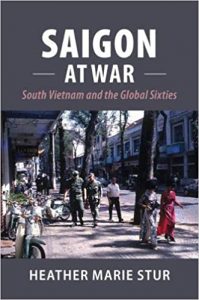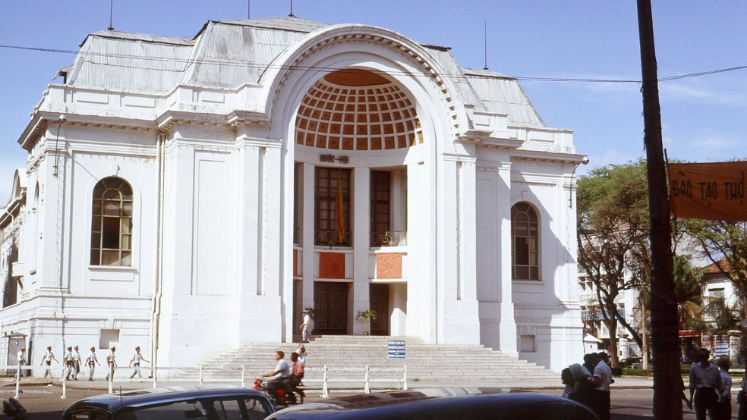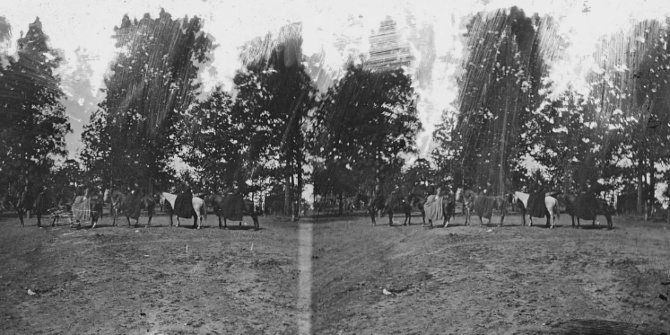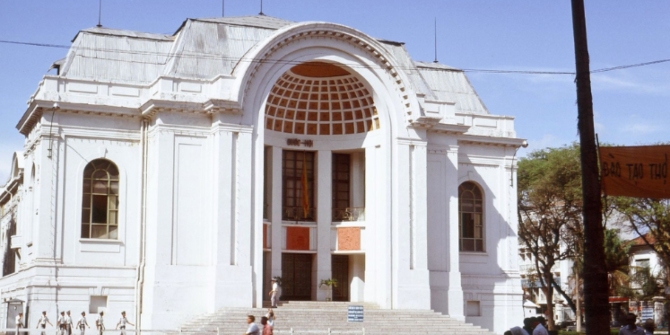In Saigon At War: South Vietnam and the Global Sixties, Heather Marie Stur challenges the conventional depiction of South Vietnam as a ‘pawn rather than an actor’, examining its wartime experience by focusing on its civil society, its social groups and activists who demanded a democratic form of government and breathed life into democratic citizenship and national politics. Rather than position this short-lived nation as the backdrop for other actors’ accounts of the wartime era, this book provides a welcome look at an understudied topic and uses vivid anecdotes and portraits to examine South Vietnam’s interior life, writes Ben Margulies.
Saigon At War: South Vietnam and the Global Sixties. Heather Marie Stur. Cambridge University Press. 2020.
Find this book (affiliate link): ![]()
 There is always something fascinating about a divided nation. A single ‘imagined community’ is split due to some internal conflict or external force, and for a time this produces two distinct versions of the same polity. This is part of what makes the US Civil War so compelling, and why German television and film have so often turned to East Germany for dramatic content.
There is always something fascinating about a divided nation. A single ‘imagined community’ is split due to some internal conflict or external force, and for a time this produces two distinct versions of the same polity. This is part of what makes the US Civil War so compelling, and why German television and film have so often turned to East Germany for dramatic content.
The Vietnam War, a part of that Cold War, has also continued to engage scholars and popular culture. The war has been the subject or setting of several classic films in the late twentieth century, and it continues to find purchase today. Spike Lee released a new film about the African-American experience of the war, Da 5 Bloods, in 2020 (which marks one of the last performances of the late Chadwick Boseman). Watchmen, the much-lauded 2019 HBO miniseries, draws on a 1986-87 graphic novel that imagines a superhero winning the Vietnam War for the US.
However, as Heather Marie Stur explains in the introduction to her new book, Saigon At War, few in the US engage with Vietnam’s experience as a divided country, or with Vietnam’s experience at all. ‘For much of the past forty years, Americans have written about the war as an American experience’, she writes, adding that ‘Historians and others have told it [the history of the war] as a story of American imperialists against Vietnamese nationalists’ without discussing South Vietnam’s domestic politics (14-15). Though the US went to war to preserve South Vietnam as a separate political entity, few historians have much interest in South Vietnam itself, which merely serves as a stage for a tale of US folly and suffering. Nor does contemporary Vietnam have much reason to consider the short-lived Southern state (officially called the Republic of Vietnam, or RVN): Stur describes her time teaching in Vietnam, where students were largely ignorant of the South, though its memory survived in Vietnamese-American communities in the US (268).
Stur’s book is a rare attempt to examine South Vietnam and its politics. She places herself alongside a small group of scholars who ‘have challenged the conventional wisdom that casts South Vietnam as a pawn rather than an actor’ (15). Focusing on the period between the 1963 coup that toppled Ngo Dinh Diem and the fall of the RVN in 1975, Stur shines a rare light on South Vietnam’s leaders and civic activists. She describes a vibrant civil society, albeit one with a limited social base, struggling to position itself between an authoritarian government, the overweening power of the US and the Northern regime and its allies in the National Liberation Front (NLF, aka the Viet Cong). She also ties South Vietnamese activism to global trends. Stur’s primary focus is South Vietnam’s civil society, the social groups and activists who demanded a democratic form of government and breathed life into democratic citizenship and national politics. These were mostly elites, focused mainly in and on the RVN’s capital, Saigon. Stur examines student unions and their leaders; activist lawyers, like Columbia-educated Ngo Ba Thanh; Buddhist and Catholic groups (the latter often seen as pro-government, the former anti-); and the NLF, which was active both in democratic politics and urban terrorism.

Stur’s book takes a partly chronological and partly subject-based approach. Saigon At War devotes chapters to the chaotic aftermath of the Diem regime, when South Vietnam endured four unstable years of military rule; the Tet Offensive of 1968; and the period after the Paris Peace Accords, when the beleaguered Republic entered its final years amid declining US interest, growing political discontent and a sagging economy.
Other chapters take a more topical approach, examining the student movement; links between South Vietnamese civil society and external actors; the interaction between South Vietnamese citizens and their state; and the Catholic minority, which moved into a critical position vis-à-vis the government of Nguyen Van Thieu, president from 1967 to 1975. The chapter on citizen-state relations is noteworthy as Stur examines how South Vietnamese citizens made claims on their state, often seeking compensation for war damages, exemptions from military service or transfers to bring relatives in the forces closer to home.
Saigon at War also looks at the era’s international relations, focusing on how the various Vietnamese governments (North, South and NLF) all sought legitimacy and support on the international stage, and how South Vietnam struggled to field competent interlocutors, despite ties with the international anti-Communist movement. Stur demonstrates how key international trends and movements influenced and interacted with South Vietnamese activism, discussing the influence of liberation theology in South Vietnam and the role US groups played in publicising the Thieu regime’s human rights abuses.
Saigon at War makes a strong argument about how Washington and Saigon mishandled their relations with South Vietnamese civil society, and how this ultimately prevented South Vietnam from developing into a viable democracy. Because South Vietnamese civil society was so fragmented, and because the NLF made liberal use of front organisations, it was difficult for US or South Vietnamese officials to tell whether the activists marching in Saigon’s streets were Communist or not. They could not identify a loyal opposition. ‘Americans’ inability to pinpoint the political affiliations of the elite Saigon activists led them to work on establishing a solid head of state first, en route to building a democratic government’ (56). South Vietnam’s leaders had the same problem telling friend from foe. The upshot was a consistently authoritarian approach to the opposition, which in time grew so alienated that it was willing to risk a Communist takeover to end the war.
Saigon At War is full of vivid portraits and anecdotes, and it gives a good overview of how South Vietnamese politics functioned in the latter half of the RVN’s short existence. The focus is admittedly narrow: Stur is very clear that her work deals with the urban bourgeoisie, and the peasant population is mentioned relatively briefly, as generally hostile to governments of all types. The book is also not a military history, making relatively few references to the conduct of the war, aside from the Tet Offensive.
Perhaps the most substantive shortcoming is that Stur does not delve deeper into an idea that she brings up more than once: that of ‘contested nationalism’. She takes this concept from Nu-Anh Tran, who argued that ‘Vietnamese above and below the seventeenth parallel [the border between the two Vietnams] battle for the right to claim themselves as the true heirs of Vietnamese nationalism’ (13). Saigon at War provides an excellent overview of certain segments of South Vietnamese politics, but it does not spend much time talking about how the RVN government or opposition activists conceived of a specifically national project. There’s a brief discussion of the country’s news agency promoting traditional performing arts and exemplary citizens (240-44), but the book is more concerned with the battle over South Vietnamese democracy and defence policy than it is about a Southern nationalist narrative.
The biggest problem with Stur’s work is less substantive than editorial. The book is badly edited – sometimes shockingly so. For example, a lengthy section of text beginning ‘The South Vietnamese government, like the communists, tried to argue that under its new way, women’s lives would become modernized and changed from the old patriarchal ways’ appears on page 155-56, and is then repeated verbatim on page 160-61. The book introduces a wire-service feature on page 241, and again two pages later. A fist fight is described three times in the course of about a page (218-19). There are also spelling errors. In some places, acronyms are introduced without explanation, and references are made to institutions (like III Corps) without any discussion of what is being described. Given increasing pressures on the publishing industry, it is not uncommon to find spelling or grammatical errors in academic texts (which, given their dense prose, are not easy to edit). However, the editing of Saigon at War seems to have been botched at several points.
Through a combination of US insularity, Vietnamese politics and perhaps academic fashions, South Vietnam has been lost to history and popular culture. It survives as a backdrop for other people’s narratives. Saigon at War is a welcome look at an understudied topic, which makes some clear, interesting judgments about South Vietnamese politics. While it is not a comprehensive history of the long-defeated Republic of Vietnam, it does provide an examination of its interior life, a portrait of a society rather than a backdrop for other actors’ accounts of the wartime era.
- This article originally appeared at the LSE Review of Books.
- Image Credit: 1967 photograph of Saigon Opera House, used as the Lower House of the Republic of Vietnam between 1955 and 1975 (Peter Stevens CC BY 2.0).
Please read our comments policy before commenting.
Note: This article gives the views of the authors, and not the position of USAPP– American Politics and Policy, nor of the London School of Economics.
Shortened URL for this post: https://bit.ly/3cKQkX1
About the reviewer
Ben Margulies – University of Brighton
Ben Margulies is a lecturer in political science at the University of Brighton. He was previously a postdoctoral fellow at the University of Warwick. He specialises in European, comparative and party politics.






